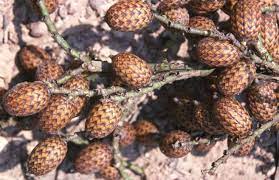Calamus erectus

Calamus erectus, also known as viagra palm and locally as tynriew, tara, and zhi li sheng teng, is a flowering shrub in the family Arecaceae.[1] The specific epithet (erectus) refers to the plant’s habit of growing straight rather than creeping or climbing like many species of the genus Calamus.
Calamus erectus is native to India (Arunachal Pradesh, Mizoram, Sikkim, Assam, West Bengal, Manipur, Meghalaya), Bangladesh, Bhutan, Nepal, Myanmar, Thailand, Laos, and China (Yunnan). It has been introduced to the United States. It grows wild in lower hill forests, especially on drier slopes, and grows frequently in the Tista and Rangit valley of West Bengal and Sikkim. It also grows in lowland and montane rainforests or drier forests, especially on steep slopes, up to 1400 meters (4593 feet) in elevation.[2]
Calamus erectus is a rattan palm, and unlike most other species in the genus Calamus, it is not climbing but grows to 3 meters (10 feet) in height. It has weakly clustering stems which measure up to 6 meters (19 feet) in length and 5 centimeters (2 inches) in diameter. The rachis bear up to 40 narrow leaves on each side, which are regularly arranged and slightly curved. They measure 60-80 centimeters (23-31 inches) in length and 3.5-5 centimeters (1-2 inches) in width. The veins are adaxial and abaxial and the margin is bristly. The stems may be upright or leaning. The leaf sheaths are dark green in color and are covered in dark brown hairs and have short rows of brown, flattened spines which measure up to 3.5 centimeters (1.3 inches) in length. Ocreas are present and have rows of short spines split into 2. Knees, flagella, and cirri are absent. The petioles and rachis have whorls of yellow to white spines. The rachis measure up to 3 meters (10 feet) in length and the petiole measures 1.5 meters (5 feet) in length. Inflorescences measure up to 2 meters (6.5 feet) in length and are not flagellate. The bracts of the inflorescences are tubular and are tattering at the tip. The calyx of the flower is 3-lobed and the lobes are apiculate, and the corolla is 3-petaled. The fruit is greenish when unripe and reddish-brown when ripe, and is ellipsoid in shape and measures 3-5 centimeters (1-2 inches) in length and 2-2.5 centimeters (0.7-1 inches) in width. The thin skin is covered in grooved scales. It normally contains 1 large, whitish seed which is edible and bland in flavor and causes dry mouth when chewed. It germinates very quickly. The first seedling leaf is pinnate and the seedling grows at a fast rate. The plant grows well in a pot and can be grown as an ornamental in warm temperate to tropical climates. It is cold hardy to US zone 9b (25-30 F or -3 to -6 C).[3]
